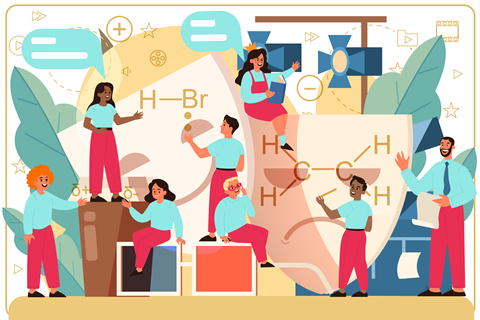Set the stage for success by helping your learners master this tricky post-16 topic

Learners often consider organic mechanisms as one of the most difficult topics in post-16 chemistry. I wanted to find an approach to teaching that would help learners build a meaningful understanding of reaction mechanisms and enable them to explain how and why we draw mechanisms in the way that we do, rather than just rote learning the diagrams.
Drama encourages engagement because it’s hands-on and collaborative, so roleplay is an ideal way to model reaction mechanisms. Having students write their own scripts encourages them to engage cognitively with what curly arrows and charges symbolise in mechanisms.
Before the lesson
In rehersals
I carried out this roleplay activity with a post-16 A-level chemistry class who had already studied the mechanisms for electrophilic addition and free radical substitution. I wrote prompt sheets based on the prerequisite knowledge needed to complete the activity, such as what a curly arrow means, what charges mean and what dipoles mean in terms of electrons.
We went to the hall and I split the class into groups of four to six students. Each group needed at least four laminated A4 sheets of plain paper made into wearable whiteboard placards with string, whiteboard pens, adhesive tape and at least six balls. Each group also had printed instructions and the prompt sheets for guidance, as well as A3 paper to write notes on.
During the lesson
Showtime
First, pupils used roleplay to recap known mechanisms, starting with electrophilic addition of hydrogen bromide (a permanent dipole) to ethene. The balls symbolised electrons and learners could be paired using adhesive tape. The wearable whiteboards were to label pupils as molecules in the mechanism. They wrote out the mechanism on A3 paper for reference while devising their roleplay.
In their groups, they worked through prompt questions such as ‘What are covalent bonds? How might you represent them?’. This prompt aimed to direct learners to hold pairs of balls between them to represent covalently bonded molecules. Other prompts made them consider how to act out a permanent dipole (holding the electrons closer to the delta negative atom), a curly arrow (transferring a pair of electrons) and different charges, before finally constructing the whole mechanism roleplay.
Once pupils had devised their roleplays, they performed them to me or another class teacher, so that we were able to spot any misconceptions and address them.
After practicing the roleplays with known mechanisms, pupils tackled new material: the nucleophilic substitution mechanism. Their instruction sheet contained the printed mechanism for the hydrolysis of bromoethane, which they were to devise a roleplay for. The prompt questions asked them to consider what a nucleophile could be and why the mechanism was so named.
After practicing the roleplays with known mechanisms, pupils tackled new material: the nucleophilic substitution mechanism. Their instruction sheet contained the printed mechanism for the hydrolysis of bromoethane, which they were to devise a roleplay for. The prompt questions asked them to consider what a nucleophile could be and why the mechanism was so named.
The extension task was to recap and roleplay free radical substitution with prompt questions about how to represent radicals and half-headed curly arrows. Due to the many steps of radical substitution, this was a good open-ended extension task to allow all pupils to finish their roleplays for nucleophilic substitution.
After the lesson
Curtain call
I repeated the roleplay activity as a starter for a later lesson. Pupils were able to successfully recall, without using notes, how to write the steps, as well as how to perform their roleplays. Pupils self-reported that the roleplay improved their cognitive engagement with organic mechanisms. I noticed that they were better able to recall mechanisms, made fewer mistakes in their drawings and answered questions with the correct terminology. They commented that the activity improved their understanding by helping them to visualise and physically embody the concepts. They particularly enjoyed the group work and, naturally, the change from the normal classroom environment.
Teaching tips
- Try to do this activity with a smaller class or alongside another chemistry teacher so you can guide each group well.
- Give clear spoken instructions and written prompts to reduce the amount of teacher intervention.
- Allow pupils to use their notes to recap the familiar mechanisms.
- If pupils are struggling to get started on the roleplay, invite a more confident group of pupils to demonstrate how they have tackled it.
Additional information
Thank you to Jo Haywood for her support in writing this article.











3 readers' comments